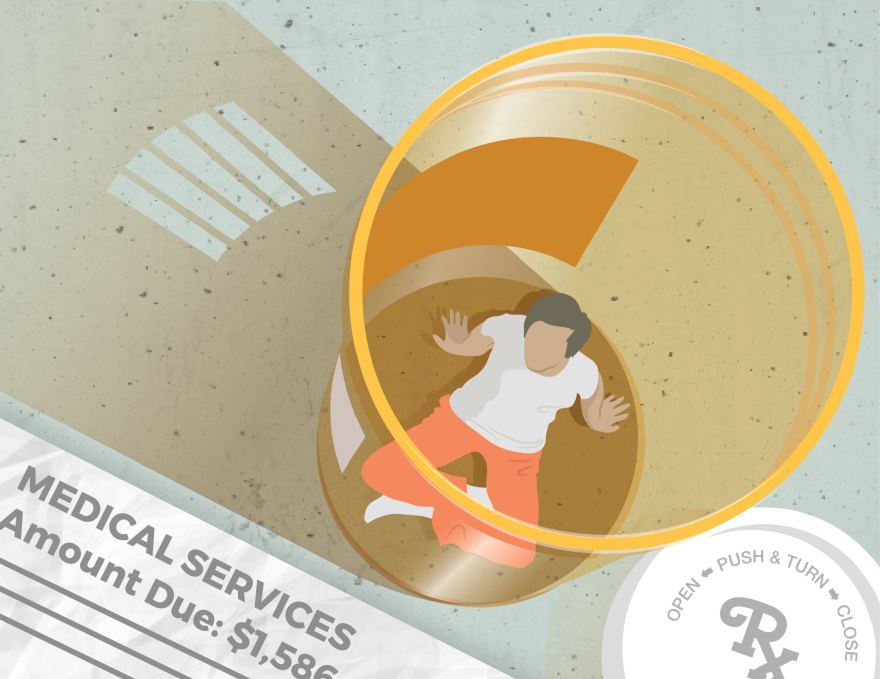Nia Sumpter, a student, mother and patient advocate, calls herself a sickle cell warrior. People with the disease — which affects red blood cells — need to see doctors all the time. Before she enrolled in health insurance, her treatment racked up thousands of dollars in hospital bills.
“With sickle cell disease, that meant I was now responsible for affording … transfusions and all of the other types of medicines,” said Sumpter, who lives in St. Louis County. “And so now I'm stuck on the hook for that. And my credit is literally like, shot.”
Sickle cell disease can be tough on a patient’s body, and it’s a lot of work juggling doctors, insurance and paperwork. That’s particularly the case for people on Medicaid, like Sumpter.
Sumpter enrolled in Missouri’s Medicaid program last year whenFor someone like her with costly medical bills, Medicaid can be a lifesaver.
She’s one of a record in Missouri’s Medicaid program — the government-funded health insurance for disabled and low-income people and families. Missouri was one of only two states that expanded its program, Mo HealthNet, during the pandemic. That made more than a 250,000 people eligible for Medicaid coverage statewide.
The federal government barred states from kicking anyone out of the program during the coronavirus pandemic. But that provision ends this spring. State officials have said they expect hundreds of thousands of people to lose their coverage. And as the state starts to review patients, it’s possible those who need health coverage will lose their insurance.

Lost in the mail
In Missouri, people enrolled in Medicaid have in the past had to prove their eligibility every year by providing the state with documentation of income, disability and other qualifying factors. Federal lawmakers in 2020 as part of a legal package that protects families from the financial effects of the pandemic.
The state and starting in May recipients will once again need to prove eligibility each year to keep coverage. That could include filling out information online or sending forms to the state Social Services Department through the mail.
St. Louis Regional Health Commission CEO Angela Fleming Brown and other health advocates are worried people will fall off the rolls even if they’re still eligible. Before the state expanded Medicaid, the commission administered a similar health coverage program for low-income people in the region.
Fleming Brown said even for that smaller-scale program, it was difficult for administrators to contact people with forms or information about their coverage.
“This is because many of the people that we find in the safety net population tend to change addresses and phone numbers frequently,” she said. “And so they'll usually get lost or they do not receive immediate termination forms.”
As a result, many don’t receive mailed or phone notices that their coverage is expiring. Some don’t know they may need to submit information to the state to keep it.
That includes Nia Sumpter. When she learned that Medicaid enrollees need to re-up their coverage every year, she put her head on the table.
“I didn't realize I had to reenroll,” she said. “Is that a thing?”
Sumpter said she hasn’t yet received any mail from the state about the need to renew coverage after the pandemic provisions end, but she has seen sporadic text messages from the state about applications. She thought they didn’t apply to her family’s situation.
“I thought once I applied I was gonna be OK,” Sumpter said. “So I kind of disregarded the text messages about reenrolling or possibly enrolling.”
Sumpter, who’s chair of the Regional Health Commission’s Patient Advisory Board, said that the constant paperwork and bureaucratic processes put people like her with chronic health conditions at risk of losing vital health coverage. She thinks people with disabilities should have continuous coverage.
She considers herself lucky she’s had a doctor who pushes her insurer to cover her treatment and keeps her updated.
“If you do not have a physician who cares about you, it can be very dangerous,” Sumpter said.

‘Not the best track record’
Missouri’s history of managing Medicaid patients worries Sheldon Weisgrau, vice president of health policy at the Missouri Foundation For Health. This year, many Missourians are on Medicaid for the first time because of the state’s expansion. They aren’t used to the annual renewal process, he said.
“Missouri does not have the best track record in this area, which is why a lot of us are watching really carefully what the state is doing,” Weisgrau said.
In 2018 and 2019, more than 100,000 Medicaid recipients — many of them children — when state officials reviewed the Medicaid program.
After Missouri struggled to process Medicaid applications for people who became eligible after the state expanded access, federal officials directed the state to improve its efforts to sign people up.
Pro-Medicaid advocates said Missouri about the changes or for coverage. As state enrollment lagged, local clinics, nonprofits .
Weisgrau said the program's expansion to more low-income adults means state officials are now faced with an unprecedented task.
“They've never had to do it at a point where the Medicaid program has this many people enrolled in it,” he said. “I mean, we are far above the highest number of Medicaid beneficiaries than we've ever been in Missouri.”
It's one thing for someone to lose eligibility who no longer meets the eligibility guidelines for Medicaid, but “it's another thing to lose eligibility for administrative reasons,” Weisgrau said. “You fall through the cracks, somehow you didn't get the letter from the state you opened it and didn't understand it. You submitted a piece of documentation that wasn't complete. And I think the real worry is that there's going to be a lot of people that fall into that category.”

Churning through the system
Todd Richardson, Missouri Department of Social Services director, told state lawmakers in a legislative hearing earlier this month that he expects close to 200,000 people to lose Medicaid coverage over the next fiscal year.
“I don’t think there’s any doubt that Missouri, like every other state in the country, expects to see enrollment come down once a full set of the redeterminations are done,” Richardson said,
Kim Evans, the director of the Social Services Department’s Family Support Division, said she’s certain Medicaid enrollment will drop during 2023. For one thing, some people have had continuous coverage even though they may be making too much money to qualify or have moved to a different insurance plan, she said.
But “we're trying to reduce what we call churn,” she said. “Churn is where [people] close because they failed to return some information to us. And then within the next 60 to 90 days, they come back in and have to reapply. We're trying to reduce that and take the burden off the participants.”
A found that two-thirds of those who lost Medicaid coverage had a period without health insurance. It also found more than 40% of people disenrolled eventually reenrolled in Medicaid within a year, indicating that they had lost coverage that they still needed.
How to prepare
However, the state has known this change was coming for a long time, and state officials say they’re in a much better position to handle renewals now than a few years ago.
“We don’t want people to panic. We’re here to help,” Evans said.
The department has made changes since 2019, she said. The agency has automated some of its systems to determine eligibility. For example, it can now use SNAP data and other information already on file to see someone’s income and determine if a person still qualifies.
“Missouri has really expanded the resources, that we have the external resources to verify information,” Evans said. “And this will be the first time that we've automated that and used it.”
The state will review eligibility gradually over more than a year, she said, going month by month. For example, if a person was enrolled in August 2022, the renewal will be in August 2023. People on Medicaid should be on the lookout for any forms coming in the mail around two months before their annual renewal date, she said.
The best way to avoid losing coverage is for patients to update their contact information at and to pay attention to texts and mail from social services, even if people usually regard them as spam, she said.






